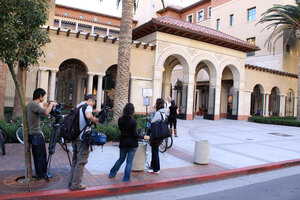NSF, School of Cinematic Arts team up to make science interactive
Hoping to make science more accessible to a wide range of people, the National Science Foundation and the USC School of Cinematic Arts have teamed up to create a new initiative that combines science and interactive media.

Moving pictures · The National Science Foundation and the USC School of Cinematic arts are aiming to make science more accessible. - Daily Trojan File Photo
The Creative Science Studio, known as CS2, aims to educate large audiences about contemporary issues in the world of science through interactive media outlets.
The idea began with NSF, which developed the concept along with USC’s Research Advancement Office in Washington, D.C. NSF had partnered with USC before and approached the school to discuss the possibility of a science and interactive media collaboration.
“NSF is worried about scientific illiteracy in the country,” said Elizabeth Daley, dean of SCA. “They want to find a way to better educate the public in fundamental scientific ideas, principles and research.”
CS2 will launch in fall 2010. It will not be a physical space on campus but rather a virtual environment run through SCA.
NSF has provided SCA with innovative resources, such as new devices and data visualization methods, to help the school achieve the goals of CS2.
The hope, Daley said, is that researchers nationwide will take advantage of CS2’s resources to make their research and findings accessible to the general population.
“If a researcher gets a major grant, they bring it to us to help them with their educational components,” Daley said. “The end result could be anything from a documentary to a game to a website.”
Cinematic arts students and faculty will have the opportunity to engage in various research projects and new forms of production through CS2. The opportunity to work with top researchers from multiple disciplines may also arise.
Students are excited by the opportunities the partnership will present.
“It sounds fantastic,” said Edwin Eversole, a junior majoring in cinema-television production. “I think cinematic arts students will be happy to be a part of this opportunity. The more information we help get out there, the better.”
Thomas Kalil, deputy director for policy for the White House Office of Science and Technology Policy, said in a statement that the White House hopes this partnership will help merge the science and entertainment worlds.
“This novel and creative partnership will enlist the power of the entertainment media to inspire audiences to learn more about science and engineering, to develop a network of scientific experts, facilities and instruments available to the arts, and bring new technologies in sight, sound and video to the marketplace,” Kalil said in a press release.
As a federal agency, NSF is looking to promote President Obama’s “Educate to Innovate” campaign, which emphasizes the importance of excelling in the sciences.
NSF and USC first partnered in 1996, when the two parties established the Integrated Media Systems Center, which has played a significant part in the expansion of the USC Viterbi School of Engineering. Over the past decade, IMSC has developed an extensive cross-disciplinary program and has become the only NSF center of excellence in multimedia and the Internet.
Daley said the key to make CS2 work is to successfully incorporate the tools used to make quality media products to improve science education and information.

Comments are closed.